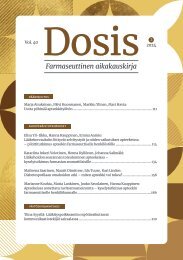Maintworld 1/2020
ROTATING EQUIPMENT SERVICES: A COMPREHENSIVE, WORRY-FREE PACKAGE // SELF-INFLICTED RELIABILITY PROBLEMS OF ROTATING MACHINERY // VIEWING MAINTENANCE AS A SYSTEM TO OPTIMIZE PERFORMANCE
ROTATING EQUIPMENT SERVICES: A COMPREHENSIVE, WORRY-FREE PACKAGE // SELF-INFLICTED RELIABILITY PROBLEMS OF ROTATING MACHINERY // VIEWING MAINTENANCE AS A SYSTEM TO OPTIMIZE PERFORMANCE
Create successful ePaper yourself
Turn your PDF publications into a flip-book with our unique Google optimized e-Paper software.
PARTNER ARTICLE<br />
(HMI/SCADA, historian, analytics, etc.)<br />
systems are backed up securely off site<br />
from where the data originates, keeping<br />
it safe from equipment damage or natural<br />
disasters.<br />
Such decentralized security measures<br />
are compelling for businesses/organizations<br />
that outgrow one central geographical<br />
location. Global enterprises,<br />
especially, see the benefits in trusting the<br />
security options provided through their<br />
cloud service providers and the integrated<br />
software that utilizes them. ICONICS<br />
IoTWorX, for instance, can connect multiple<br />
buildings, factories, and equipment<br />
through secure TLS encryption and popular<br />
cloud platforms, such as Microsoft<br />
Azure and Amazon Web Services. Data<br />
can be accessed from anywhere through<br />
a pub/sub architecture for real-time<br />
visualization of KPI data at the edge.<br />
IoTWorX delivers an efficient, secure<br />
connection to the cloud through bidirectional<br />
AMQP for Microsoft Azure,<br />
as well as MQTT, REST, and WebSockets<br />
for third-party cloud providers.<br />
Expanded Connectivity<br />
Another benefit of utilizing cloud-based<br />
automation solutions is that there is often<br />
an increase in the number of available<br />
communication protocols that can be<br />
used. This is in addition to the advanced<br />
security measures (bidirectional AMQP<br />
transport protocol [for Microsoft Azure]<br />
and MQTT, REST, and WebSockets [for<br />
third-party providers]) that cloud-based<br />
solutions provide.<br />
For maintenance operations, it’s definitely<br />
a benefit to be able to “talk to” as<br />
many of the machines within the organization<br />
as possible. As an example, ICON-<br />
ICS IoTWorX software is compatible<br />
with multiple standard communication<br />
protocols. These include protocols specific<br />
to plant floor applications; such as<br />
OPC Classic, OPC Unified Architecture<br />
(OPC UA), and Modbus; as well as those<br />
specific to building automation (BACnet)<br />
and IT hardware (SNMP). This provides<br />
users with the ability to communicate<br />
with a wider array of connected<br />
equipment, ultimately enabling users to<br />
better detect potential issues and utilize<br />
an organization’s data, wherever it might<br />
be created, transmitted, or stored.<br />
Cloud Contingencies<br />
For those concerned about the viability<br />
of cloud-based solutions during interruptions<br />
to internet service, there are<br />
measures that can be put into place to<br />
help ensure data doesn’t go missing or<br />
get corrupted. ICONICS has solutions<br />
that provide rapid data archiving and retrieval,<br />
including a "store-and-forward"<br />
feature that is useful when a network<br />
connection is unavailable; one specifically<br />
edge-based (IoT Hyper Collector)<br />
and the other traditionally on-premises<br />
or cloud-enabled (Hyper Historian).<br />
IoT Hyper Collector is part of IoT-<br />
WorX, the previously mentioned micro-<br />
SCADA software suite installed on a<br />
third-party IoT edge device. The collector<br />
has the ability to replay buffered<br />
data back locally, as well as to store and<br />
forward to the cloud when connectivity<br />
is present. For a more traditional<br />
on-premises approach, ICONICS Hyper<br />
Historian Collector also utilizes a similar<br />
store-and-forward feature. If a collector<br />
has lost connectivity to the logger, it will<br />
continue to buffer the data until connectivity<br />
is reestablished.<br />
Best of Both<br />
While the IoT Hyper Collector and<br />
Hyper Historian Collector are examples<br />
of how to retain data integrity both via<br />
the cloud and on-premises, respectively,<br />
there is nothing to prevent an organization<br />
from taking a hybrid approach.<br />
This bridges the gap between OT and<br />
IT and alleviates any "silo effect" of the<br />
organization’s data collection, storage,<br />
and retrieval. The same can be said for an<br />
organization’s entire automation solution<br />
and related data, as a whole. Some<br />
may benefit from a strictly cloud-based<br />
solution. Others may still have reason<br />
to remain with an entirely on-premises<br />
one. However, neither has any restriction<br />
towards using elements of the other<br />
in such a hybrid scenario.<br />
Each organization will make its own<br />
determination regarding what works<br />
best for their business processes and operations<br />
(cloud, on-premises, or hybrid),<br />
as well as to the automation software<br />
vendors that can best support it.<br />
18 maintworld 1/<strong>2020</strong>

















